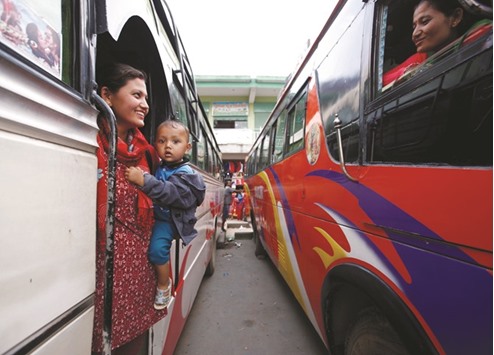Even though it was 4am, student Mukesh Kuwar arrived at the main bus park at Gongabu in Kathmandu to get a bus ticket to go home to Dhangadhi in western Nepal, only to find he was at the back of the queue.
Kuwar’s home is located 723km away from the capital city.
Despite the early hour, he was behind throngs of others also queuing up for tickets to return to their hometowns.
All those waiting for tickets had one thing in common: they were all travelling home to meet family and friends to celebrate Dashain, the biggest festival in Nepal, Xinhua reports.
As the ticket counter opened at 6am, Kuwar started to complain at 8am that he should have arrived earlier; perhaps at 3am to guarantee that he could get a ticket home.
“I thought I came there early enough, but now I’m a bit worried I won’t be able to buy a ticket,” Kuwar.
Although his family will not be celebrating the festival this year because of a death in the family, Kuwar still wants to meet his family members and relatives.
“I am also excited to go home because it has been a whole year since I last saw my relatives,” said Kuwar.
Punam Thing, a homemaker, was also worried about whether or not she would get a ticket or not on Thursday, as she queued to book a ticket to travel to the Gorkha district, in central Nepal, to be with relatives at her maternal home.
She arrived at the bus terminal at around 5am and was still queuing three hours later. “They are saying that there are only three buses with vacant seats left and I am worried about all of them running out of seats before my turn comes to get ticket,” she said.
The bus station is a hive of activity, as a large number of people waiting for bus tickets and then waiting for the buses to depart for their destinations are all in a rush to get back to their hometowns to celebrate the festival, which started on October 1.
The festival is basically celebrated for 10 days. The last day is the most important day of the festival, however, when people receive ‘tika’ (a mark of vermilion and rice on the forehead) and blessings from elders. The 10th day, known as tika, will be celebrated on October 11 this year.
Kathmandu, the capital city, hosts a large migrant population as they come here from different parts of the country in search of for better work and educational opportunities.
The Dashain festival period is when the largest numbers of migrants depart the capital city ever year. According to the Federation of Nepalese National Transport Entrepreneurs, around 1mn people have already departed from the Kathmandu valley and an additional 1mn are expected to move out from the city within the next three to four days as the festival swings into gear.
According to Saroj Sitaula, general secretary of the federation, more than 3,000 passenger vehicles have been departing Kathmandu every day for the last few days, which is triple the number compared to regular days. To deal with the mass exodus of people, some entrepreneurs have secured other vehicles from different parts of the county to offer private services.
Not only from the migrant population within the country, but many from overseas also travel home for the festival. Given the mass movement of people, the Nepal police said they are prioritising the safety of people travelling on the buses and other passenger vehicles.
Police spokesperson Hemanta Malla Thakuri said that they have distributed time cards to the passenger vehicles to control the speed of drivers so that the vehicles operate at a safe speed as they head towards their destinations.
There is a tendency among public vehicles here to carry more passengers than their capacity and to drive at higher speeds, but this can lead to fatal accidents.
“The government didn’t accept the transport entrepreneurs’ demand for permission to carry passengers beyond the existing standard and they were forced to operate their vehicles under the existing rule,” said Malla.

Passengers speak with each other as they wait for long distance buses to head towards their village for Dashain festival, at the bus station in Kathmandu yesterday.
